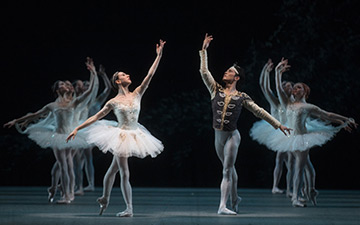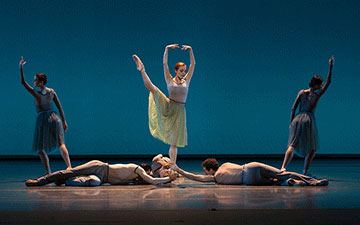
© Gene Schiavone. (Click image for larger version)
American Ballet Theatre
La Bayadère
New York, Metropolitan Opera House
1, 5 June 2015
www.abt.org
In the Temple of Love
What makes a ballet feel stale? The question hovered insistently in my mind as I watched two performances of American Ballet Theatre’s La Bayadère this week at the Metropolitan Opera House. It’s never been my favorite ballet. The story is a classic love tangle, but with an exotic twist: it’s set in a kingdom in a mythical India of the distant past. A temple dancer (or bayadère) is desired by a high priest but loves a proud warrior, who, in turn, is betrothed to a wilful princess. The setting, however, is completely at odds with the waltzy, music-hall score by Ludwig Minkus. The look, or “plastique” – a favorite word of balletomanes – is only intermittently exotic. The midriff-baring costumes and golden, or purple, tutus are incongruous. And yet, in the past, I remember enjoying its luxuriant atmosphere and appreciating its sheer preposterousness: the stuffed tiger in the first act, the hoochy-koochy harem girls at the Raja’s palace, the curled fingers of the golden idol, and the final earthquake that swallows up the cast in the end.
The ballet has its transcendent moments, of course – otherwise, it wouldn’t have survived for as long as it has. It premièred in St. Petersburg in 1877, with choreography by Marius Petipa. This production, from 1980, is by Natalia Makarova, who often performed La Bayadère as a young dancer in Soviet Russia. Hers was the first full production of the ballet in the West. The most famous passage is the “Shades” scene: twenty-four women in white, representing spirits, descend in slow succession down a ramp – sorry, the Himalayas – repeating the same sequence of steps, over and over. It is a scene of intense poetry, one of those images of celestial harmony to which ballet is particularly suited. American Ballet Theatre’s corps de ballet dances it beautifully, with a gentle lilt, creating an illusion of shared breath.
Another stirring set piece is the heroine’s keening dance in front of her lover and his betrothed in the moments before her death (by snake-bite), full of slow bourrées, floating balances and deep, aching backbends. It prefigures the opening step of the Shades, an arabesque on a bent leg, followed by a step backwards, back arched. A great ballerina like Alina Cojocaru (who danced the role on June 5) can make much of this moment, her body transmitting the desperation of loss and betrayal and, by the end, an acceptance of death. More often, though, the passage looks like a demonstration of legato technique; this was the case on Monday, in a cast led by Hee Seo. A beautiful but impassive performer, Seo failed to fill the steps with any deeper meaning.

© Gene Schiavone. (Click image for larger version)
The character of Solor, her lover, is little more than a cardboard cutout, a cog in the machinery of the story. He exists to look handsome and proud, to partner with assurance, to leap with panache. On June 1 the part was danced by Kimin Kim, of the Mariinsky. Like Seo, he is lithe and elegant and strikes a handsome profile. His jumps and turns are astonishingly clean; he jets through the air with the force of a torpedo. But his acting, at least here, is mannered and his partnering somewhat labored. On June 5, Herman Cornejo gave the character more weight. He was convincingly impassioned in the first act and reacted to the news of his forced betrothal with touching bewilderment. His soaring jumps had urgency, purpose. The pas de deux between Nikiya and Solor during the Shades scene lit up the theatre.
There were other fine performances too, particularly on June 5: Roman Zhurbin as a heartbroken High Brahmin; Skylar Brandt, Stephanie Williams, and Cassandra Trenary in the tricky solos for the three lead Shades; Joseph Gorak as an impossibly exacting Bronze Idol. As Gamzatti, (June 5), Misty Copeland was appropriately icy and assured but had trouble getting much air in her jumps. On June 1, Gillian Murphy, in the same role, was grander and much, much meaner.
But no end of fine, or even inspired, performances can breathe life into this tired production. After watching a reimagined Sleeping Beauty just last week, with its wealth of newly-polished steps and mime and renewed sense of purpose, one can only long for a similar re-examination of La Bayadère.

















I saw La Bayadere today with Kim Kimin, Heo Seo and Gillian Murphy (June 6th matinee). Overall I enjoyed the ballet, but there were some good and bad surprises.
I was greatly disappointed with the choice of Heo Seo for the part of Nikiya. She has beautiful face and beautiful physic, but that was about it. She does not have much stage presence, not very musical and not very strong technically. Forgive me my harsh but honest words, she looked like an understudy in one of the college productions. In contrast Gillian Murphy was spectacular, had amazing stage presence, she can dance and she can be in character.. Kim Kimin’s jumps were predictably amazing, There was a wonderful and unexpected surprise – the corpse de ballet was beautifully syncronized, down to the angles of their head tilts? and movements of the wrists, the musicality is great. It is pretty rare for the large corpse de ballet scenes to be that syncronized and that musical. A delightful surprise indeed. I felt the corpse de ballet today was on the comparable level with Mariinsky theater amazingly syncronized troupe.
One more thing that is worth mentioning -final calls etiquette. It is great that Kim Kimin and Heo Seo appeared for final calls together, but honestly Heo Seo should have stepped aside and allowed Kim Kimin to receive his well deserved applause at some point/ The chance she gave his was not enough, and was not properly handled. I felt cheated – guest artist did not have a chance to receive much applause for himself. To put it bluntly Heo Seo received an undeserving dose of applause that was not meant for her. I was so disappointed in her performance that most she could hope from me would be a couple of polite soft claps. There was quite a bit of dissatisfied talk about her performance among the visitors.
I personally wish her much luck and trust that with proper training one day she will be a great star. However, this day is not here it, she has a lot of learning and growing to do. For the time being, I will make sure to stay away from any of the performances where she is cast in one of the parts, I will also advice my friends to do the same.
[…] After seeing two performances of Natalia Makarova’s La Bayadère at American Ballet Theatre I was left feeling that the ballet has gone a bit stale. You can read my review of the two casts, for DanceTabs, here. […]